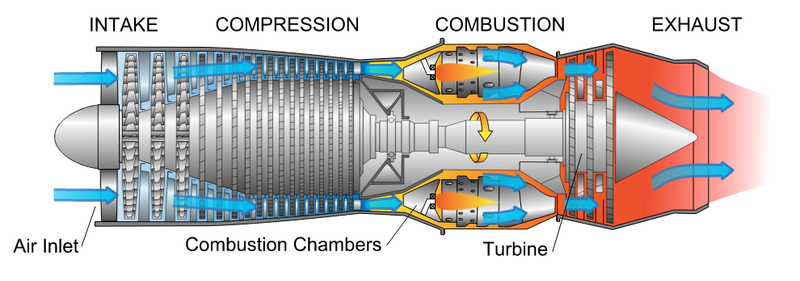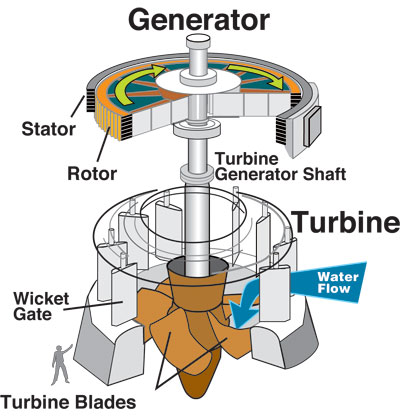Turbine
A turbine is a device used in power generation, engines, and propulsion systems. It often looks like a propeller, which is a kind of turbine. Due to this, it is shaped so that a propellant can be used to turn it, like a gas turbine or in a hydroelectric facility, or so that it can be used for propulsion like the propeller on a submarine.
Use in heat engines
Turbines are commonly used in heat engines, as they are highly efficient at high outputs, and require little maintenance. In the case of a gas turbine, compressed air is heated, then mixed with fuel. When the mixture ignites, it expands rapidly, and the expanding air is pushed into the turbine, causing it to spin. This is the technology used in airplanes, and also the technology used in many electricity generators. Because they use compressed air, high altitudes do not affect the efficiency of turbines, making them ideal for use in planes. They are not traditionally used in cars because they take a long time to ramp up and down their power generation.

Electricity generation
Dams

The heart of any hydroelectric facility (Dam) is the turbine. Water is taken from the source behind the dam, and used to spin the turbine. By connecting the turbine to a generator, dams are able to create electricity using nothing but the flow of water.
There are many factors that go into the selection of an appropriate Turbine for a site. Some factors include but are not limited to: Hydrostatic head, Discharge, the rotational speed, the cost, and the specific speed.
The main two types of turbines found in hydroelectric facilities are the Reaction turbines and the Impulse turbines. Reaction turbines utilize water under pressure that is deflected towards blades. These turbines must be encased or submerged to maintain the water pressure. Unlike Reaction turbines, Impulse turbines do not need to be submerged since they rely on the velocity of water from a pressurized nozzle to strike the blades.
The image above illustrates the schematics of a hydroelectric turbine (Kaplan turbine). The water is deflected through the wicket gates (aka guide vanes or distributor) into the blades (aka runners depending on design of turbine) where the spinning causes a Generator attached to the shaft of the blades to generate electricity. The human figure gives a sense of the sheer size of these hydroelectric turbines.
Generators
Turbines are used in many electricity generators. This is because a generator must output a consistent amount of power over a potentially long period of time, which turbines are very efficient at doing. The turbine blades are connected to a generator, which then generates electricity using the power from the turbine.
References
- ↑ Wikimedia Commons [Online], Available: https://upload.wikimedia.org/wikipedia/commons/4/4c/Jet_engine.svg
- ↑ US Army Corps of engineers, public domain, accessed from http://commons.wikimedia.org/wiki/File:Water_turbine.svg.

